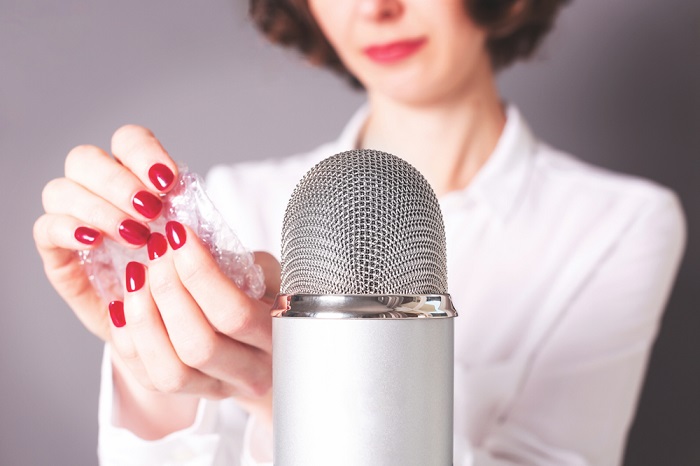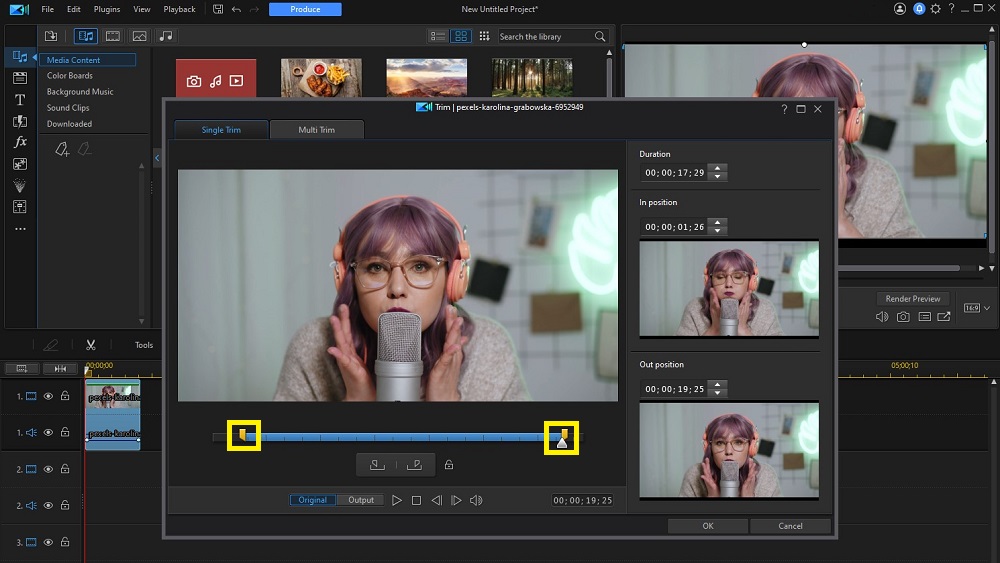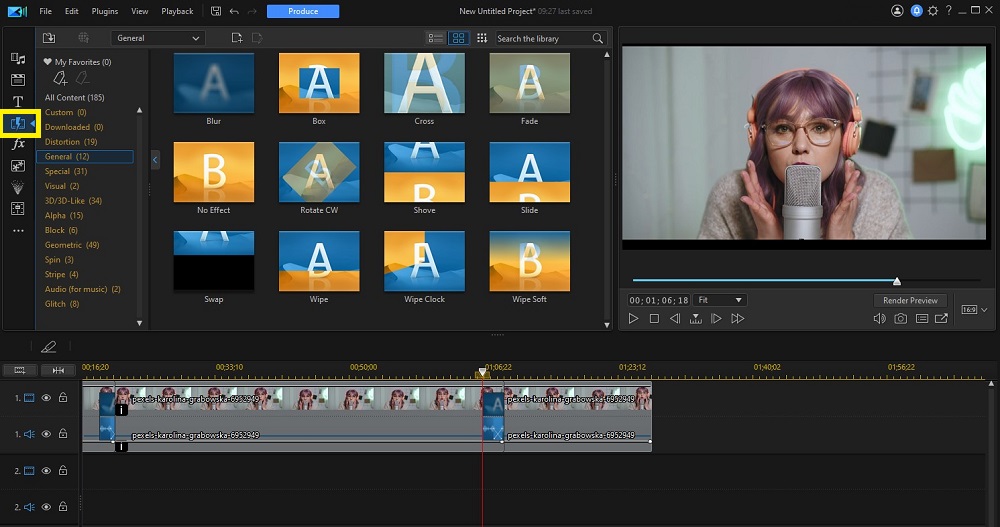How to Make Brain Tingling ASMR Videos [Step-by-Step Guide]

Autonomous Sensory Meridian Response sounds incredibly technical and scientific, but the YouTube sensation known as ASMR videos is anything but.
What exactly are ASMR videos, and how can you cater to the millions of people obsessed with this phenomenon? In this article, we will answer these questions and give you all information on this popular trend.
- What are ASMR Videos?
- What is the Best Editing Software for ASMR Videos?
- How to Shoot and Record an ASMR Video
- How to Edit an ASMR Video
- What Do You Need to Make an ASMR Video?
- What is the Best Mic for an ASMR Video?
- What is the Best Camera for an ASMR Video?
- 5 Tips on Making ASMR Videos
- Download the Best ASMR Video Editing Software for Free
- ASMR Videos FAQ
What are ASMR Videos?
The term ASMR was first coined in 2010, and the YouTube phenomenon surrounding it has been growing ever since. In fact, ASMR is one of YouTube’s highest searched terms in the US.
ASMR refers to the tingling sensation one can get when feeling relaxed or sleepy. It usually starts at the scalp and goes down the spine, but people can experience ASMR in different ways.
ASMR YouTubers try to trigger that feeling in their viewers. They do this by speaking in a calm voice, making tapping or eating sounds close to the microphone, or role-playing scenes such as going to the hairdresser or getting a massage. YouTubers constantly try to develop new sounds (snapping a Cheeto in half! Running a makeup brush over LEGO bricks!) and let the viewers tell them what worked.
Millions of people have started watching ASMR videos to relieve stress or help them sleep. Many viewers even say it helps with chronic pain and PTSD. But unfortunately, there is no real science behind ASMR, and what is relaxing to some could be cringe-worthy to others. And while many people don’t even experience the physical tingling caused by ASMR, they can still get the enjoyment and relaxation from watching these videos.
Since there isn’t a lot of science on the subject, it’s hard to describe how ASMR videos work. All the data is based on word-of-mouth – just people on the internet describing what works for them. But through viewer comments and Facebook groups, ASMR YouTubers have discovered a few categories that are the most popular for triggering tingles, such as whispering and crisp sounds.
What is the Best Editing Software for ASMR Videos?

PowerDirector - Best Overall Software
Want your visuals to be beautiful and calming with as little effort as possible? PowerDirector - A video editing software does precisely that. With ready-made templates for YouTube intros and outros, customizable titles, and audio enhancements, you can have your ASMR videos edited and uploaded directly to YouTube within minutes.
You can create smooth transitions with PowerDirector, so your viewers won't be abruptly snapped out of their euphoric state of mind. There is a chroma key tool for green screens so that you can replace backgrounds. You can change the color of your videos or blur the edges around yourself for a soothing effect. And most importantly, PowerDirector comes with speech enhancement capabilities, which reduce unwanted background noise for a crisp and clear audio.
It also has an extensive library of sound effects, from animal to kitchen sounds. Choose serene music from a vast royalty-free stock library and tailor background music to fit the length of your video with Smart Fit.
Download PowerDirector for free below:

AudioDirector - The ultimate audio editing tool
If you are editing on Windows, another option for editing your ASMR videos is with AudioDirector - The ultimate audio editing tool. AudioDirector removes reverb and echo from your audio clips and comes with restoration tools for distraction-free vocals without distortion.
Download it for free below and check out its game-changing audio enhancing features:
How to Shoot and Record an ASMR Video

Now that you’ve learned what ASMR videos are, it’s time to start making your own! Below is a step-by-step guide on how to make ASMR videos.
- Decide what to film
If this is your first foray into the world of ASMR, start with the most popular triggers. These include whispering, fingernail tapping or gliding over different objects, eating sounds, role-playing, and skincare/makeup. Choose something you are comfortable doing because if you are tense, the audience will be too.
- Prep the room
Make sure your room is soundproof. If there is an echo, hang sheets/blankets or add furniture to absorb sound. If you are setting up a permanent home studio, you should invest in acoustic foam.
An interior room is best to eliminate outside noise, but if that’s not an option, try filming late at night when outdoor/neighbor noise is minimal.
After sound-proofing, work on the visuals. Unless you are planning to green screen the whole thing, the room you choose needs to be clear of clutter and distractions, with soft furnishings and lighting.
- Practice sounds/speaking
Test your microphone and practice speaking on different sides. Then, listen back to your voice to ensure there aren’t any plosives or sibilance.
If you are making ASMR sounds with various props, try them out beforehand and ensure the mic is picking them up. Adjust the room and microphone placement as necessary.
- Record your video
Speak in a low, melodic voice and pay attention to your grooming. Just like you checked the audio before recording, you should also see how you look on video.
Some ASMR videos are as long as 4 hours, so make sure your equipment is charged or plugged into a power source before starting.
- Edit your video
Upload your footage into your video editor. Then, trim the video, fix the sound, and add any other voiceover, music, or sound/visual effects needed to round out the experience.
As with any other YouTube video, don’t forget to add an intro and outro with your logo and social media info. Branding is an essential part of getting traffic to your ASMR videos.
How to Edit an ASMR Video
You've shot your video. Now let's get into the step-by-step of editing your ASMR video.
- Import video and audio files
Ensure you have enough room on your hard drive, especially if your ASMR video is long. Also, plug your camera into a power source before importing so it won't die in the middle.
If you use your smartphone for filming, you can edit directly on your phone or import your footage onto your computer. If you shoot with a camera, connect it to your computer or remove the SD card and insert it.
Most editing software, such as PowerDirector, have an Import Files button you can use to move the media directly from the outside source into your editing suite, saving the step of transferring to your desktop.
- Add media to timeline
After importing your files, drag and drop them onto your editing timeline in the order you want them played. You can always move them around once they are on the timeline.
- Split and trim video
Splitting a clip means cutting it into two parts. For example, you would do this if you are cutting back and forth between multiple shots or you want to add an effect to only one part of a clip.
Trimming is cutting off a few seconds at the beginning or end of a clip.
You can also mark a clip "in" and "out" so it will start and stop where you want.

- Add Transitions or Special Effects
Adding a transition is helpful if you want to gently fade from one clip to another without feeling abrupt or choppy – something you want to avoid in ASMR.
PowerDirector has a variety of transitions to choose from, and you can drag and drop them between two clips or at the end of one on your timeline.

Special effects for ASMR videos could include green screen or masking objects out to help with visual clutter or adding glitter effects to mimic the sounds you are creating.
An example of good special effects used in an ASMR video is found below in this video from Scottish Murmurs ASMR:

- Fix/Add Audio
This is a crucial part of any ASMR video edit.
Remove background noise and fix any pops or hisses. If you need help doing this, AudioDirector comes with powerful AI speech enhancement tools that will eliminate hiss, hums, and plosives with the click of a button.
Add in background music or sound effects to enhance or replace recorded sounds. Play with the sound levels and lower anything that sounds too loud.

- Add Title and End Cards
Don’t forget titles and end cards, as they help viewers find you again and guide them to your other content and social media pages.
PowerDirector has text and intro/outro templates to make this step quick and easy.

- Produce and Upload
With PowerDirector, you simply click the Produce button and choose the format you want your file.
PowerDirector also allows you to link your YouTube account to upload the finished video directly onto the site.
What Do You Need to Make an ASMR Video?
There are four key ingredients you need to make your own ASMR video:
- A Room
- Equipment
- Performance
- Editing Software or App
A Room: This sounds pretty obvious, but as mentioned above, much thought and care need to go into the room where you make your ASMR video.
The first thing to think about is the location. So much of ASMR has to do with sound, so the room should be quiet with no street sounds and noisy neighbors. Think of it as a recording studio and sound-proof it as such.
Next, think of the lighting in the room. ASMR is all about relaxing and helping viewers sleep, so harsh overheads and fluorescent lights should be extinguished. Instead, light candles or turn on lamps with warm, low-wattage bulbs.
And finally, the décor. Are there distracting posters all over the walls or a messy desk in the background? Clutter equals stress, so make your setting as neutral and relaxing as possible. You don’t have to completely redo your room to get this effect. Simply angle the camera towards a neutral-colored wall and add a couple of pillows for softness. If there’s nowhere to turn for a calm setting, hang a blanket or use a green screen.
Equipment: The two most obvious are a camera and microphone. For many YouTube videos, a big podcast-worthy microphone isn’t necessary. But for ASMR, it’s a must.
Most ASMRtists whisper during their videos, so relying on your camera/desktop/phone mic to pick up sound is not good enough. Also, many ASMR creators interact with the microphone, tapping it with their hands or other objects for the desired effect. And unless you are making a video of just whispering for an hour, you will need props. These could be items to create specific sounds or props for a role-play video, like a brush and clippers for a pretend trip to the hairdresser.
Performance: It’s the performance that genuinely creates that ASMR tingle. Speak and move slowly. If whispering, practice in front of the mic and listen back to hear how it sounds. You may need to move closer/further away. Practice speaking into the side of the mic instead of directly into it.
All your movements should be soft and slow. If doing a role-play ASMR video, write out a script of affirming and sympathetic words. Personal attention is a big ASMR trigger, so look directly into the camera and make each viewer feel like you are talking directly to them.
Editing Software or App: You will need a good editing software or app to finish your ASMR video. The sound is more important than the visuals for most ASMR, so choose an editing software with good audio options. You will need to sync your sound and video, play with sound levels, eliminate unwanted noise, and add sounds and voiceover in post.
If you’re looking for the best software or app for creating ASMR videos, try out PowerDirector. It’s available on iOS, Android, Mac, and Windows, and it’s free to download. It has all the tools you’ll need to edit both video and audio to create engaging and stimulating ASMR videos.
What is the Best Mic for an ASMR Video?

ASMR is all about sound, so choosing the best microphone is vital. The Blue Yeti USB Mic for recording and streaming on PC and Mac is the highest rated amongst ASMRtists. Of course, there are more professional mics out there for more money, but Blue Yeti is affordable. It plugs directly into your computer, has a headphone jack for sound monitoring, and can be easily moved. Most importantly for ASMR, it is a multipattern mic, allowing for four different pickup patterns.
Microphones have traditionally come in 1 of 3 pickup patterns; omnidirectional, figure-8, and cardioid. In an omnidirectional mic, the whole circle around the microphone is sensitive to sound. In a figure-8 mic, the front and back of the mic are sensitive, while the sides are not. Finally, in a cardioid mic, the front of the mic is susceptible to sound, the sides are slightly less so, and the back does not pick up sound at all.
A multipattern mic allows you to switch back and forth between different patterns. In ASMR, many performers prefer speaking into the sides of the mic rather than the front to avoid sibilance (the hissing noise that occurs when you say an "S" word). Maybe you record in front of your computer and don't want the back of the mic to pick up the computer hiss. The options you have in a multipattern mic make it the best mic for ASMR.
Purchasing a pop filter for your mic helps avoid plosives, the popping noise made when you say "P" and "B" words. Many ASMR performers also buy two mics, one for the right and one for the left, to give the viewer binaural sound. Binaural sound is how we hear things in real-life – usually louder in one ear than in the other. It feels more natural to the listener and therefore helps them feel relaxed and sleepy.
What is the Best Camera for an ASMR Video?
Since audio is more important than visuals in ASMR videos, any camera you choose should have a plug-in for a separate mic. Also, make sure your image is stable, so invest in a tripod or a camera with image stabilization. Shaky images are not relaxing.
Your camera should also record in a format your editing software can handle. It would be a shame to spend money on a mic, camera, and editing software to find out none work together. Also, look into the sensor size – a large sensor or mirrorless camera is best for low-light – a staple of ASMR videos.
If you are on a budget, the Panasonic Full HD Video Camera Camcorder HC-V180K has an optical zoom, suitable for dimly lit conditions, image stabilization, records in Full HD 1080p, and includes creative controls like miniature effect and time-lapse. And if you aren’t purchasing a professional mic, this camera has excellent sound quality. It’s also much cheaper than the Panasonic HC-V770, a more professional camera but doesn’t add anything you would need to make an ASMR video.
5 Tips on making ASMR Videos
Tip 1: Remember that ASMR is a very personal experience. People don’t experience it in the same way. So don’t feel discouraged if not everyone digs your vibe. Just keep trying new things and watch plenty of videos yourself to see what the ASMR community is doing.
Tip 2: Don’t do anything that makes you uncomfortable.
Tip 3: Remember to prep your room (and yourself) to look as soothing and uncluttered as possible.
Tip 4: Test all of your sounds and whisper before filming, and adjust your mic settings accordingly.
Tip 5: With every decision, remember the objective – to offer viewers euphoric tingles and maybe even put them to sleep.
Download the Best ASMR Video Editing Software for Free
The best editing software for ASMR is PowerDirector because of its ease of use, ready-made templates, AI-powered speech enhancement tools, and extensive sound effects/music library. Plus, you can upload your videos directly to YouTube.
If you are working on a Windows computer, try AudioDirector for everything you need to record and edit sound on a professional level. It has a range of restoration tools to get crisp, clear, distraction-free vocals.
Both are available for free download!


ASMR Videos FAQ
Here’s how to fix the audio in your ASMR videos using the Speech Enhancement feature in PowerDirector.
Mac and Windows
- Import an audio clip that contains dialogue into PowerDirector, then drag it to the editing timeline.
- Click Fix/Enhance, then Speech Enhancement.
- Adjust the level of the Speech Compensation or the Removal Strength with the sliders provided.
- Click Apply.
iOS and Android
Here’s how to fix the audio in your ASMR videos by using the Audio Tool in the PowerDirector app.
- Hit New Project and choose a video to edit.
- Tap on the video in the timeline to bring up the Edit Menu along the bottom.
- Hit Audio Tool.
- Hit Denoise, then adjust the strength with the slider.
- When complete, hit the Check Mark to save.
Click here to learn how to remove background noise from your ASMR videos.
The top five features you should look for are
- Speech enhancement tools
- Green screen and object removal
- Transitions library
- Direct upload to YouTube
- YouTube templates for title and end cards
If you’re looking for a product that checks all of these boxes, we recommend PowerDirector.
- PowerDirector
- Premiere Elements
- Pinnacle Studio 25 Ultimate
- Shotcut
- Final Cut Pro
- iMovie
- Movavi
For more information on the above software, visit 7 Best Video Editing Software for YouTube.




